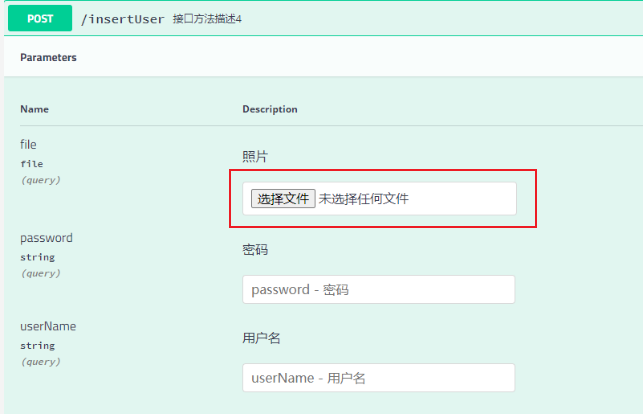在编写接口时,将所有参数封装到实体中,其中就包含MultipartFile类型的参数
eg:
参数实体:User
@ApiModel(value = "用户实体类")
@Data
public class User {
@ApiModelProperty(value = "用户名")
public String userName;
@ApiModelProperty(value = "密码")
public String password;
@ApiModelProperty(value = "照片")
public MultipartFile file;
}
接口:
@ApiOperation(value = "接口方法描述4")//这是给接口方法添加注释的
@PostMapping(value = "/insertUser")
public String insertUser(User user){
return "我是用户="+user.getUserName();
}
显示正常时:

调用接口:

发现文件为,null
解决方式:@ApiImplicitParams(dataType="__file",paramType="form")设置参数类型和传参方式
参数支持类型:

package springfox.documentation.schema;
import com.fasterxml.classmate.ResolvedType;
import com.google.common.collect.ImmutableMap;
import org.springframework.web.multipart.MultipartFile;
import java.lang.reflect.Type;
import java.math.BigDecimal;
import java.math.BigInteger;
import java.util.Currency;
import java.util.Date;
import java.util.Map;
import java.util.Set;
import java.util.UUID;
import static com.google.common.collect.Sets.*;
public class Types {
private Types() {
throw new UnsupportedOperationException();
}
private static final Set<String> baseTypes = newHashSet(
"int",
"date",
"string",
"double",
"float",
"boolean",
"byte",
"object",
"long",
"date-time",
"__file",
"biginteger",
"bigdecimal",
"uuid");
private static final Map<Type, String> typeNameLookup = ImmutableMap.<Type, String>builder()
.put(Long.TYPE, "long")
.put(Short.TYPE, "int")
.put(Integer.TYPE, "int")
.put(Double.TYPE, "double")
.put(Float.TYPE, "float")
.put(Byte.TYPE, "byte")
.put(Boolean.TYPE, "boolean")
.put(Character.TYPE, "string")
.put(Date.class, "date-time")
.put(java.sql.Date.class, "date")
.put(String.class, "string")
.put(Object.class, "object")
.put(Long.class, "long")
.put(Integer.class, "int")
.put(Short.class, "int")
.put(Double.class, "double")
.put(Float.class, "float")
.put(Boolean.class, "boolean")
.put(Byte.class, "byte")
.put(BigDecimal.class, "bigdecimal")
.put(BigInteger.class, "biginteger")
.put(Currency.class, "string")
.put(UUID.class, "uuid")
.put(MultipartFile.class, "__file")
.build();
public static String typeNameFor(Type type) {
return typeNameLookup.get(type);
}
public static boolean isBaseType(String typeName) {
return baseTypes.contains(typeName);
}
public static boolean isBaseType(ResolvedType type) {
return baseTypes.contains(typeNameFor(type.getErasedType()));
}
public static boolean isVoid(ResolvedType returnType) {
return Void.class.equals(returnType.getErasedType()) || Void.TYPE.equals(returnType.getErasedType());
}
}
通过上面Types类可以看到设置dataType为__file,paramType为form即可设置参数类型和传参方式
@ApiOperation(value = "接口方法描述4")//这是给接口方法添加注释的
@PostMapping(value = "/insertUser")
@ApiImplicitParams({@ApiImplicitParam(paramType = "form", dataType="__file", name = "file1",value = "照片啊", required = false)})
public String insertUser(User user){
return "我是用户="+user.getUserName();
}

成功接收到
注:我这里用的swagger版本是2.9.2,此版本使用"__file"设置参数为文件对象,低版本中使用的是"file"
swagger 注解:
@Api:用在请求的类上,表示对类的说明
tags="说明该类的作用,可以在UI界面上看到的注解"
value="该参数没什么意义,在UI界面上也看到,所以不需要配置"
@ApiOperation:用在请求的方法上,说明方法的用途、作用
value="说明方法的用途、作用"
notes="方法的备注说明"
@ApiImplicitParams:用在请求的方法上,表示一组参数说明
@ApiImplicitParam:用在@ApiImplicitParams注解中,指定一个请求参数的各个方面
name:参数名
value:参数的汉字说明、解释
required:参数是否必须传
paramType:参数放在哪个地方
· header --> 请求参数的获取:@RequestHeader
· query --> 请求参数的获取:@RequestParam
· path(用于restful接口)--> 请求参数的获取:@PathVariable
· body(不常用)
· form(不常用)
dataType:参数类型,默认String,其它值dataType="Integer"
defaultValue:参数的默认值
@ApiResponses:用在请求的方法上,表示一组响应
@ApiResponse:用在@ApiResponses中,一般用于表达一个错误的响应信息
code:数字,例如400
message:信息,例如"请求参数没填好"
response:抛出异常的类
@ApiModel:用于响应类上,表示一个返回响应数据的信息
(这种一般用在post创建的时候,使用@RequestBody这样的场景,
请求参数无法使用@ApiImplicitParam注解进行描述的时候)
@ApiModelProperty:用在属性上,描述响应类的属性
原文章地址: